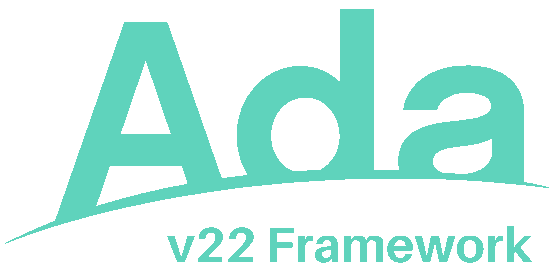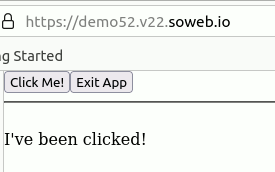Description
Click Me! is a simple multi user Gnoga application.
This tutorial is designed to introduce:
- Gnoga.Application.Multi_Connect – Initialize connectivity in a multi-usre context.
- User app specific data.
- Multiple URL paths
Download Gnoga for more tutorials and demos.
Source code
-- In the previous tutorials we created Singletons applications where there
-- is no issue of concurrency outside of events from the same user. This
-- allowed for programming in the familiar sequential patterns of regular
-- console applications. In this tutorial we will create an application that
-- will allow for multiple connections on the same machine, network or across
-- the globe on the internet.
--
-- In order to help see the different approach to setting up the application
-- we will do something similar to the previous tutorial.
with Gnoga.Application.Multi_Connect;
with Gnoga.Gui.Base;
with Gnoga.Gui.Window;
with Gnoga.Gui.View;
with Gnoga.Gui.Element.Common;
with Gnoga.Types;
-- Gnoga special types are found in Gnoga.Types.
procedure Tutorial_03 is
use all type Gnoga.String;
-- Since this application will be used by multiple connections, we need to
-- track and access that connection's specific data. To do this we create
-- a derivative of Gnoga.Types.Connection_Data_Type that will be accessible
-- to any object on a connection.
type App_Data is new Gnoga.Types.Connection_Data_Type with record
My_Window : Gnoga.Gui.Window.Pointer_To_Window_Class;
My_View : Gnoga.Gui.View.View_Type;
My_Button : Gnoga.Gui.Element.Common.Button_Type;
My_Exit : Gnoga.Gui.Element.Common.Button_Type;
end record;
type App_Access is access all App_Data;
procedure On_Click (Object : in out Gnoga.Gui.Base.Base_Type'Class);
procedure On_Exit (Object : in out Gnoga.Gui.Base.Base_Type'Class);
-- Events for our application. The implementation is almost identical
-- to our previous tutorial. However we access the elements through our
-- App_Data data structure associated with the connection instead of
-- globally.
procedure On_Click (Object : in out Gnoga.Gui.Base.Base_Type'Class) is
App : constant App_Access := App_Access (Object.Connection_Data);
begin
App.My_View.New_Line;
App.My_View.Put_Line ("I've been clicked!");
end On_Click;
procedure On_Exit (Object : in out Gnoga.Gui.Base.Base_Type'Class) is
App : constant App_Access := App_Access (Object.Connection_Data);
View : Gnoga.Gui.View.View_Type;
begin
App.My_View.Remove;
View.Create (App.My_Window.all);
View.Put_Line ("Application exited.");
App.My_Window.Close_Connection;
exception
when E : others =>
Gnoga.Log (Message => "On_Exit: ", Occurrence => E);
end On_Exit;
procedure On_Connect
(Main_Window : in out Gnoga.Gui.Window.Window_Type'Class;
Connection : access Gnoga.Application.Multi_Connect.Connection_Holder_Type);
-- Instead of creating and setting up our GUI in the main body of the
-- application, we now set up the GUI in a connection event handler.
-- The implementation is almost identical to the last tutorial except we
-- place our GUI element variables within the App_Data data structure
-- that will be associated with the connection.
procedure On_Connect
(Main_Window : in out Gnoga.Gui.Window.Window_Type'Class;
Connection : access Gnoga.Application.Multi_Connect.Connection_Holder_Type)
is
pragma Unreferenced (Connection);
App : constant App_Access := new App_Data;
begin
App.My_Window := Main_Window'Unchecked_Access;
Main_Window.Connection_Data (App);
-- This associates our application data to this connection. Now any
-- object created on it has access to it using its Connection_Data
-- property. When the connection is done it will deallocate the memory
-- used.
App.My_View.Create (Main_Window);
App.My_Button.Create (App.My_View, "Click Me!");
App.My_Button.On_Click_Handler (On_Click'Unrestricted_Access);
App.My_Exit.Create (App.My_View, "Exit App");
App.My_Exit.On_Click_Handler (On_Exit'Unrestricted_Access);
App.My_View.Horizontal_Rule;
end On_Connect;
begin
Gnoga.Application.Title ("Tutorial 03");
Gnoga.Application.HTML_On_Close ("Application ended.");
Gnoga.Application.Multi_Connect.Initialize;
Gnoga.Application.Multi_Connect.On_Connect_Handler (Event => On_Connect'Unrestricted_Access, Path => "default");
-- With a Multi_Connect application it is possible to have different
-- URL paths start different Connection Event Handlers. This allows
-- for the creation of Web Apps that appear as larger web sites or as
-- multiple applications to the user. Setting Path to "default" means
-- that any unmatched URL path will start that event handler. A URL path
-- is the path following the host and port. For example:
-- http://localhost:8080/test/me
-- The Path would be "/test/me". In Gnoga the path can even appear to be
-- a file name "/test/me.html". However if you have a file of the same
-- name in the html directory it will be served instead.
Gnoga.Application.Multi_Connect.Message_Loop;
end Tutorial_03;Project file
with "settings.gpr";
with "gnoga.gpr";
project Tutorial_03 is
for Object_Dir use Settings.Obj_Dir;
for Exec_Dir use Settings.Exe_Dir;
for Main use ("tutorial_03.adb");
for Create_Missing_Dirs use Settings'Create_Missing_Dirs;
package Compiler renames Settings.Compiler;
package Binder renames Settings.Binder;
package Linker renames Settings.Linker;
package Pretty_Printer renames Settings.Pretty_Printer;
end Tutorial_03;
